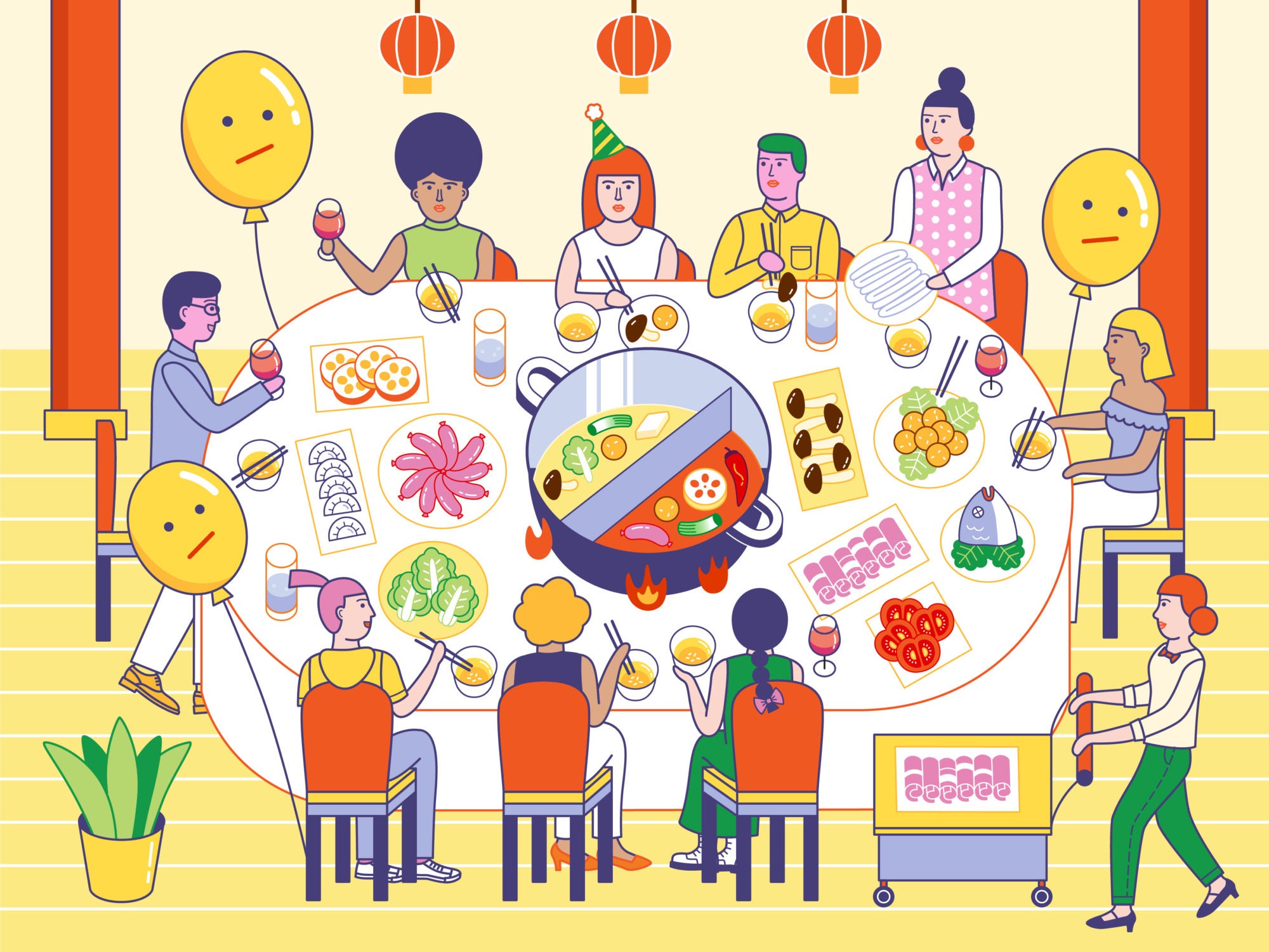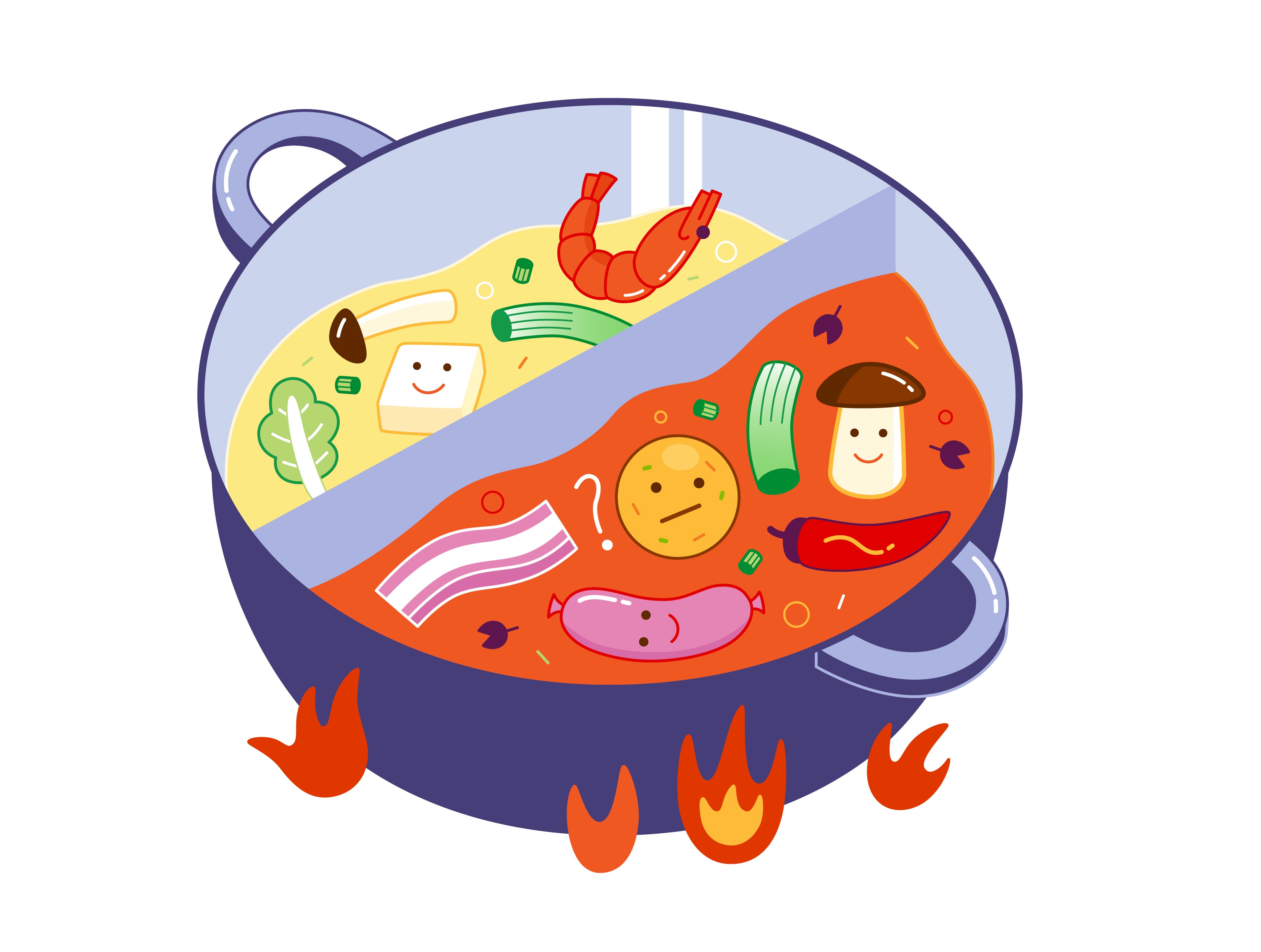
Hot pot is an enormously popular category of Chinese food. But is it possible that this has more to do with the social act of cooking it than with the end result?
With thousands of restaurants in China dedicated to custom dipping-sauce bars and steaming centerpieces ready to cook whatever’s dropped inside, it’s clear that hot pot has an audience. It’s consistently ranked as the most popular cuisine in the country—no small feat with a population of 1.3 billion. And the phenomenon isn’t confined to China. You can witness Haidilao’s famous noodle dancers from Chengdu to Cupertino and satisfy your burning desire for Sichuan chiles in basically all 50 states. Despite all the promise of fragrant broths and meat platters—not to mention Barbies wearing meat dresses—I’ve never totally understood the craze.
I can’t help but feel a bit underwhelmed each time I experience hot pot, mostly at restaurants but sometimes at home. How exciting can sliced beef cooked in spicy broth be? The meal edges toward monotony pretty quickly—wilty bok choy, bite-size beef, chewy noodles, repeat. All the textures blend together after a while; there’s no distinctive crisp or crunch. It’s all soft-boiled bite after bite. And there’s no major difference in taste, whether you pay $20 for a buffet-style extravaganza or $60 for premium cuts of wagyu and organic vegetables. It all gets dunked in the same sauce anyways. After eating hot pot dozens upon dozens of times in both China and America, I still didn’t “get it”—and feel a bit ashamed to even say I dislike it, given my Chinese background and the growing worldwide craze for it. There has to be something I’m missing. But ultimately, what ends up on my plate isn’t the satisfying part—it’s everything else: the communal experience, the customization, the theatrics.
Regardless of regional differences (Chongqing style with Sichuan peppercorns being the most pervasive), all hot pot rituals follow similar etiquette: The table shares the cooking pot, surrounded by a spread of raw ingredients waiting to be dipped into the flavored stock. Despite coming from a region specializing in mild, seafood-focused hot pot, my Cantonese family never made it at home, so there may have been a certain nostalgia factor that I’m missing.
“It’s less about the food, and more about the group you’re eating with,” a friend who grew up in Beijing explains to me. “I always associate hot pot with my mom spending more time preparing food for other people instead of eating for herself.” Communal dining is central to Chinese culture, with most dishes made family-style, but hot pot has a heightened sense of intimacy. “It’s a good way to get people around the table and you’re sort of forced to talk and take care of each other,” my friend continues.
Part of the beauty of Chinese hot pot is that virtually every aspect of it is both customizable and social. A steaming and rapidly bubbling pot of your broth of choice—it could be pork bone, seafood, tomato—is surrounded by plates of ruby red slices of raw rib eye, threads of enoki mushroom, honeycomb beef tripe, and silken tofu waiting to be cooked in it. You can make your own dipping sauce to be used once your proteins and vegetables are prepared, adding as much or as little sesame paste, garlic, or hoisin as you’d like to a small saucer. And when it comes to dining with a large group, catering to all types of tastes is easy. Not everyone can handle the mala broth, made with mouth-numbingly spicy Sichuan peppercorn? Order a yuanyang pot that divides down the middle, making room for two different flavored stocks. Someone’s a vegetarian? Get a meat-free broth, pile on the leafy greens, and indulge in the many forms that tofu takes.

Tang Hot Pot, a restaurant in New York, contextualizes both its longstanding tradition, around for over 1,000 years, and social implications. They explain: “Hot pot in China is [as] much about a social event as it is another meal—think backyard BBQ as an American equivalent.”
Yu Li, the restaurant’s founder, speaks of hot pot’s multipurpose nature on the Feast Meets West podcast. “You can go [to a hot pot restaurant] after work with your colleagues, or you can go there for birthday parties. It’s an every-occasion meal. You can also go there late at night and have some beer.… It’s more about the experience. Nobody eats hot pot alone.”
Food and travel writer Matt Gross chimes in to tell me, “I love how hot pot helps a group bond: You decide together what goes in when—although there are norms: hardier veg first, noodles last, meat throughout—and you make sure that everyone gets enough of everything, including their favorite ingredients.”
The answer to hot pot I was looking for wasn’t locked in complex flavor profiles of Sichuan peppercorns or the nuances of herbaceous soup bases. It doesn’t involve the bone broth I was sick of or the same garlic-sesame sauce I make every time, either. It’s deeply personal, reminding me of what brought me to the table in the first place, whether it was celebrating milestones or simply mundane: rounding up a group of 12 for a birthday and sharing a single cooking pot (which was as disastrous as it sounds), venturing outside of the dorm with my roommate for the first time (even if it was only a five-minute walk away), or finding a hot pot restaurant out of pure convenience when everything else was closed during Lunar New Year.
It has nothing to do with overboiled noodles or the murky puddle of soup that diluted the sauce dish. It’s about sitting shoulder-to-shoulder with friends and bonding over our love for copious amounts of garlic, swapping sauces to see who made the best one, chugging Qingdaos to suppress the spice—the frenzy to scoop up the food that’s rightfully yours.